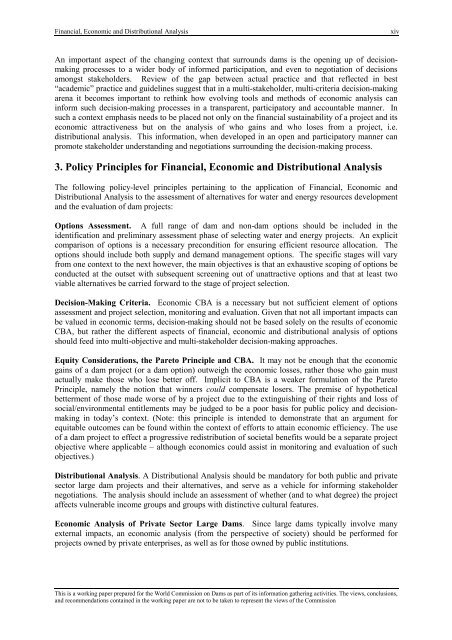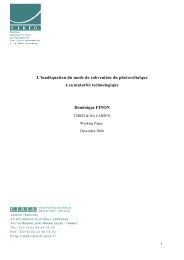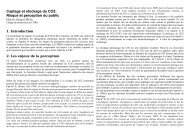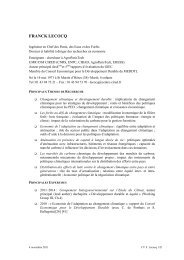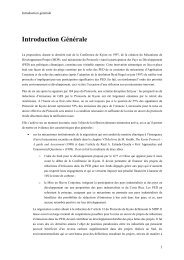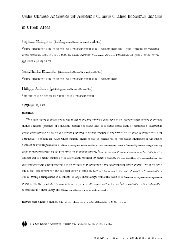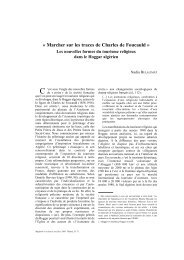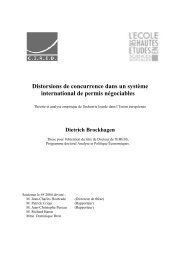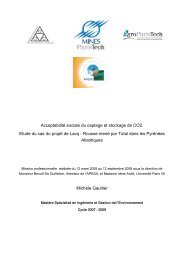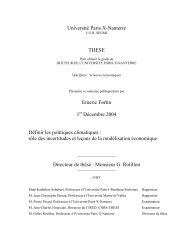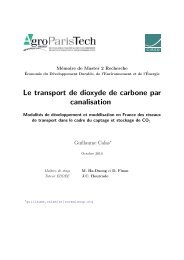Financial, Economic and Distributional Analysis - Centre ...
Financial, Economic and Distributional Analysis - Centre ...
Financial, Economic and Distributional Analysis - Centre ...
You also want an ePaper? Increase the reach of your titles
YUMPU automatically turns print PDFs into web optimized ePapers that Google loves.
<strong>Financial</strong>, <strong>Economic</strong> <strong>and</strong> <strong>Distributional</strong> <strong>Analysis</strong>xivAn important aspect of the changing context that surrounds dams is the opening up of decisionmakingprocesses to a wider body of informed participation, <strong>and</strong> even to negotiation of decisionsamongst stakeholders. Review of the gap between actual practice <strong>and</strong> that reflected in best“academic” practice <strong>and</strong> guidelines suggest that in a multi-stakeholder, multi-criteria decision-makingarena it becomes important to rethink how evolving tools <strong>and</strong> methods of economic analysis caninform such decision-making processes in a transparent, participatory <strong>and</strong> accountable manner. Insuch a context emphasis needs to be placed not only on the financial sustainability of a project <strong>and</strong> itseconomic attractiveness but on the analysis of who gains <strong>and</strong> who loses from a project, i.e.distributional analysis. This information, when developed in an open <strong>and</strong> participatory manner canpromote stakeholder underst<strong>and</strong>ing <strong>and</strong> negotiations surrounding the decision-making process.3. Policy Principles for <strong>Financial</strong>, <strong>Economic</strong> <strong>and</strong> <strong>Distributional</strong> <strong>Analysis</strong>The following policy-level principles pertaining to the application of <strong>Financial</strong>, <strong>Economic</strong> <strong>and</strong><strong>Distributional</strong> <strong>Analysis</strong> to the assessment of alternatives for water <strong>and</strong> energy resources development<strong>and</strong> the evaluation of dam projects:Options Assessment. A full range of dam <strong>and</strong> non-dam options should be included in theidentification <strong>and</strong> preliminary assessment phase of selecting water <strong>and</strong> energy projects. An explicitcomparison of options is a necessary precondition for ensuring efficient resource allocation. Theoptions should include both supply <strong>and</strong> dem<strong>and</strong> management options. The specific stages will varyfrom one context to the next however, the main objectives is that an exhaustive scoping of options beconducted at the outset with subsequent screening out of unattractive options <strong>and</strong> that at least twoviable alternatives be carried forward to the stage of project selection.Decision-Making Criteria. <strong>Economic</strong> CBA is a necessary but not sufficient element of optionsassessment <strong>and</strong> project selection, monitoring <strong>and</strong> evaluation. Given that not all important impacts canbe valued in economic terms, decision-making should not be based solely on the results of economicCBA, but rather the different aspects of financial, economic <strong>and</strong> distributional analysis of optionsshould feed into multi-objective <strong>and</strong> multi-stakeholder decision-making approaches.Equity Considerations, the Pareto Principle <strong>and</strong> CBA. It may not be enough that the economicgains of a dam project (or a dam option) outweigh the economic losses, rather those who gain mustactually make those who lose better off. Implicit to CBA is a weaker formulation of the ParetoPrinciple, namely the notion that winners could compensate losers. The premise of hypotheticalbetterment of those made worse of by a project due to the extinguishing of their rights <strong>and</strong> loss ofsocial/environmental entitlements may be judged to be a poor basis for public policy <strong>and</strong> decisionmakingin today’s context. (Note: this principle is intended to demonstrate that an argument forequitable outcomes can be found within the context of efforts to attain economic efficiency. The useof a dam project to effect a progressive redistribution of societal benefits would be a separate projectobjective where applicable – although economics could assist in monitoring <strong>and</strong> evaluation of suchobjectives.)<strong>Distributional</strong> <strong>Analysis</strong>. A <strong>Distributional</strong> <strong>Analysis</strong> should be m<strong>and</strong>atory for both public <strong>and</strong> privatesector large dam projects <strong>and</strong> their alternatives, <strong>and</strong> serve as a vehicle for informing stakeholdernegotiations. The analysis should include an assessment of whether (<strong>and</strong> to what degree) the projectaffects vulnerable income groups <strong>and</strong> groups with distinctive cultural features.<strong>Economic</strong> <strong>Analysis</strong> of Private Sector Large Dams. Since large dams typically involve manyexternal impacts, an economic analysis (from the perspective of society) should be performed forprojects owned by private enterprises, as well as for those owned by public institutions.This is a working paper prepared for the World Commission on Dams as part of its information gathering activities. The views, conclusions,<strong>and</strong> recommendations contained in the working paper are not to be taken to represent the views of the Commission


